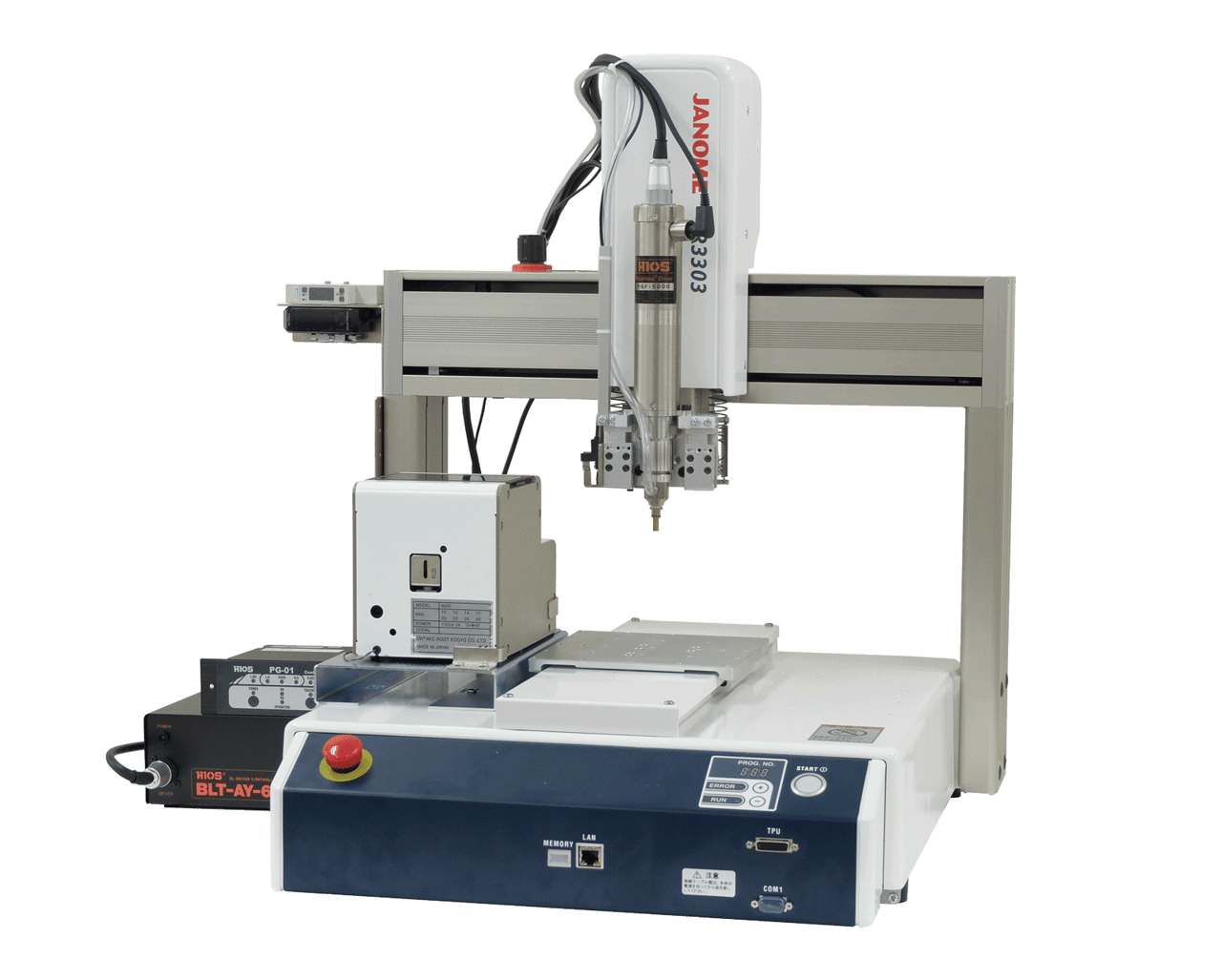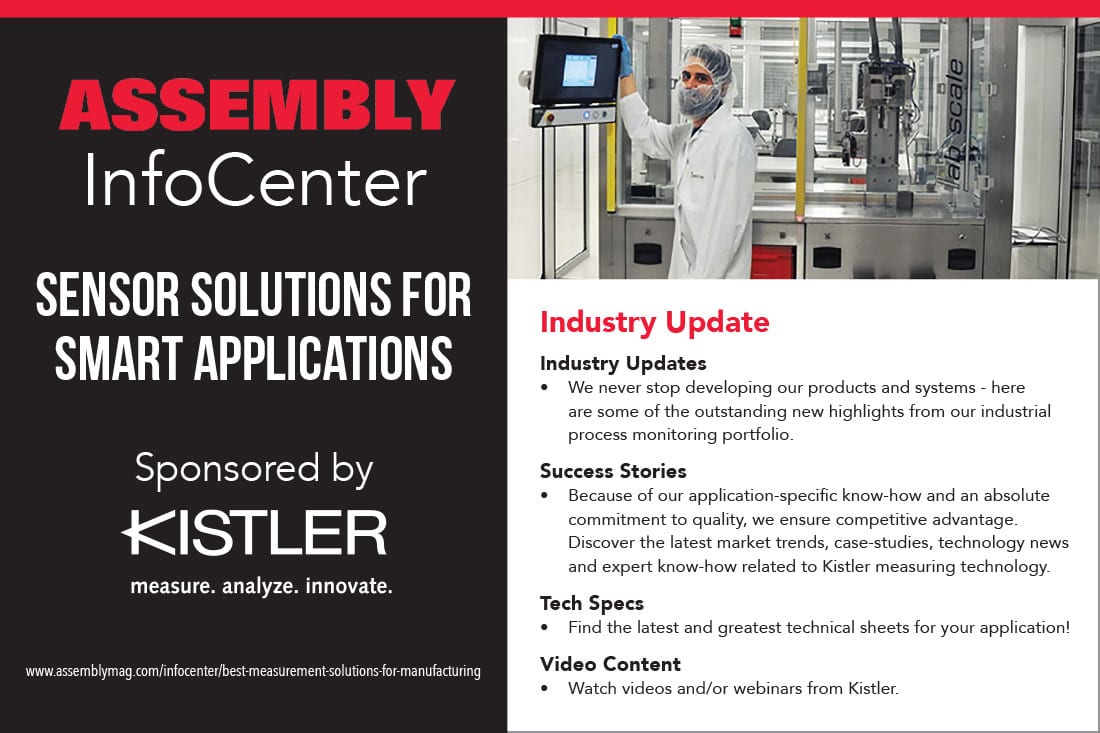Screwdriving
New Tech for
Robotic Fastening
John Sprovieri // Chief Editor
Screwdriving is a perfect application for Cartesian, SCARA and six-axis robots.

An automatic screw feeder can greatly increase the efficiency of a manual screwdriving operation. However, to reach the next level of productivity, assemblers should consider a robot. Screwdriving is a great application for Cartesian, SCARA, six-axis robots and collaborative robots. Now, several suppliers have introduced robots for installing large screws and bolts. Here’s a look at some of the latest developments.
SCARA Robots Install Fasteners
The ERS robotic workcell can be equipped with a Handy 2000 Micro nutrunner for fasteners ranging from M1.7 to M6 or a Handy 2000 Touch nutrunner for fasteners ranging from M3 to M12. Photo courtesy ESTIC America Inc.
The ERS series of preconfigured robotic workcells from ESTIC America Inc. are designed for automatic installation of threaded fasteners. Two sizes of SCARA robot are available. The THE400 SCARA has a maximum reach of 485 millimeters and a Z axis stroke of 160 millimeters. The THL900 SCARA has a maximum reach of 1,000 millimeters and a Z axis stroke of 160 millimeters. The robot can be equipped with a Handy 2000 Micro nutrunner for fasteners ranging from M1.7 to M6 or a Handy 2000 Touch nutrunner for fasteners ranging from M3 to M12. The cells can be ordered with or without a linear actuator to move workpieces in and out. Alternatively, the cell can be configured to interface with a pallet-transfer conveyor. One controller governs both the nutrunner and the robot. This simplifies programming and reduces communication time. Tightening points can be taught by moving the robot directly. An optional vision guidance system automatically corrects misalignment of the tool with the fastening location. Z axis thrust control prevents workpiece overload and cam out during tightening. For more information, visit www.estic-global.com.
Screwdriving Cell With Cobot

The PD400UR automatic screwdriving cell features a UR5E cobot from Universal Robots and an electric screwdriver from Nitto Seiko America. Photo courtesy Nitto Seiko America
The PD400UR automatic screwdriving cell features a UR5E six-axis cobot from Universal Robots and an electric screwdriver from Nitto Seiko America. The cell is UR+ certified. The robot can be programmed via teach pendant. The driver—model NX020T3, NX050T3 or NX100T3—can apply torque ranging from 0.5 to 6 newton-meters. Maximum driver speed is 1,100 rpm. The cobot retrieves fasteners from a screw presenter using a magnetic or vacuum bit. The tool can install Phillips, hex head and Torx drive styles. Screws range in size from M2.5 to M5, with a maximum length of 15 millimeters and a maximum head diameter of 9 millimeters. The driver controller, SD600T, collects run-down data and stores 16 fastening programs. For more information, visit www.nittoseikoamerica.com.
Conveyorized Screwdriving Cell

The AX-40 automatic screwdriving cell includes a robot, conveyor, screw feeder, screwdriver, frame and safety light curtain. Photo courtesy ASG, Division of Jergens Inc.
The AX-40 automatic screwdriving cell from ASG, Division of Jergens Inc., includes a robot, conveyor, screw feeder, screwdriver, frame and safety light curtain. The cell can be integrated with a new or existing conveyor. The standard conveyor is provided with a stop gate and lift-out station to ensure accuracy during the screwdriving process. The standard pallet size is 400 by 400 millimeters, but larger pallets can be accommodated on request. The cell has a steel base and an aluminum framing enclosure with safety-latched doors and a sliding drawer for the screw feeder. The standard controls package is an Allen Bradley PLC and HMI, but other control brands are available on request. Three drivers are available: ASG X-PAQ SD2500, X-PAQ EH2 or Fiam driver. Torque ranges from 0.1 to 500 newton-meters. The screw feeder can be equipped with a 1- or 3-liter bowl.
Several robots are available: a two- or three-axis Cartesian robot with a range of 600 millimeters per axis; a two- or three-axis Cartesian robot with a range of 1,000 millimeters per axis; a SCARA robot with a maximum reach of 550 millimeters; a SCARA robot with a maximum reach of 850 millimeters; and a six-axis robot with a maximum reach of 900 millimeters. For more information, visit www.asg-jergens.com.
Desktop Screwdriving Robot

This standardized desktop screwdriving robot includes an electric screwdriver, automatic screw feeder and JR3000 desktop Cartesian robot. Photo courtesy Janome Industrial Equipment USA Inc.
This standardized desktop screwdriving robot from Janome Industrial Equipment USA Inc. includes an electric screwdriver, automatic screw feeder and JR3000 desktop Cartesian robot. Janome’s dedicated screw tightening software is easy to program and enables engineers to set various parameters, including torque, depth and screw pitch. Automation ensures that screws are installed in the same positions, depth and torque every time. The software detects errors, such as floating screws, screws that spin inside the hole, dropped screws and empty screw feeders. The robot is compatible with a wide range of torque-controlled screwdrivers. The robot can install screw sizes from M1 to M6 and can handle torque ranging from 0.02 to 4.5 newton-meters. For more information, visit www.janomeie.com.
Collaborative Robot Screwdriving System
The lightweight tooling allows this cobot to move at maximum speed without sacrificing collaborative safeguards. Photo courtesy Visumatic Industrial Products
Visumatic Industrial Products has launched the VCM-3X.2 collaborative robot module for automatic screwdriving. It includes an automatic screw feeder, drive system, skeleton robot program, and an end-effector for mounting directly to the wrist of a cobot. The lightweight tooling mitigates the inertia effect on the robot’s sensors and allows the robot to move at maximum speed without sacrificing collaborative safeguards. The tooling also has a close center of mass, which minimizes the cantilever effect. The compact size of the tooling enables the robot to clear obstacles with less motion.
Preprogrammed fault-recovery logic enables the robot to automatically continue screwdriving after a safety stop. This occurs without operator intervention, maintaining process efficiency.
The screwdriver incorporates Visumatic’s bit-advance assembly with dual-powered motion for precise, controlled fastener installation. Position sensors on the slide confirm advancement and retraction of the bit, reporting to the robot controller that it is OK to move when the bit reaches the home position. This ensures a repeatable joining operation. Other sensors report that a screw has been fed, that a fastening cycle has stared, and that torque is good or bad. For more information, visit www.visumatic.com.
Screwdriver for Six-Axis Robots

The Model SD-185 screwdriver is designed to be positioned by a six-axis robot. The driving head can be universally mounted at any attitude and the feed system may be located away from the driving head. Photo courtesy Dixon Automatic Tool Inc.
The Model SD-185 screwdriver from Dixon Automatic Tool Inc. is designed to be positioned by a six-axis robot. The driving head can be universally mounted at any attitude and the feed system may be located away from the driving head. This mounting arrangement is advantageous when limited mounting space is available or when mounting multiple driving heads in close proximity to one another.
The driver head is equipped with placement jaws and a feed tube attachment. The feed tube conveys the fasteners from a vibratory feeder bowl to the placement jaws. A wide range of fastener types can be fed and driven by this screwdriver. The size of the feeder bowl ranges from 9 to 36 inches in diameter, depending on the fastener size. Fasteners can be driven into a workpiece to either a predetermined torque setting or to a specific depth setting. The screwdriver head has built-in sensing to confirm proper insertion of each fastener.
Head stroke ranges from 3 to 5 inches. The driver can install screws with a diameter of 2.8 to 6.4 millimeters, a maximum length of 38.1 millimeters, and a maximum head diameter of 13.2 millimeters.
This screwdriver may be purchased as a complete tooled system with controls and vibratory feed system. For more information, visit www.dixonautomatic.com/abg.
Screwdriver Certified for UR Cobots

This lightweight automatic screwdriving system is certified for use with cobots from Universal Robots. Photo courtesy DEPRAG Inc.
Lightweight automatic screwdriving systems from DEPRAG Inc. are now certified for use with cobots from Universal Robots. The system can be combined with step, sword and vibratory feeders, as well as screw presenters. The controller can store 15 screwdriving programs. With clamp force control, the driver can reliably detect the seating point of the fastener. Automatic documentation of process data, such as such as torque, angle, depth and time, guarantees 100 percent traceability. For more information, visit www.depragusa.com.
System Offers Fast Changeover

With this robotic screwdriving system, changeover can be accomplished in 5 minutes. Photo courtesy Robotiq
Robotiq’s Screwdriving Solution is a UR+ certified automatic screwdriving system for cobots from Universal Robots. The system includes an SD-100 screwdriver, an SF-300 screw feeder, vacuum sleeves, driver bits, Force Copilot software, and screwdriving application software. Changeover from one application to another can be accomplished in 5 minutes. Engineers can program the screwdriver directly with the cobot’s teach pendant. The system provides precision fastening to torques of 1 to 4 newton-meters. It also has error-proofing features for uninterrupted screwdriving, such as screw presence detection, torque control and position monitoring. For more information, visit https://robotiq.com.
ASSEMBLY ONLINE
For more information on robotic screwdriving, visit www.assemblymag.com to read these articles:


